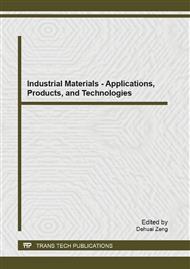[1]
Dobson, A.P., Bradshaw, A.D., Baker A.J.M., 1997. Hopes for the Future: Restoration Ecology and Conservation Biology. Science, Vol. 277 (25): 515-522.
DOI: 10.1126/science.277.5325.515
Google Scholar
[2]
Sasaki, N., Putz, F.E., 2009. Critical need for new definitions of forest" and "forest Degradation, in global climate change agreements. Conservation Letters, 1-7.
DOI: 10.1111/j.1755-263x.2009.00067.x
Google Scholar
[3]
Hobbs, R.J., Norton, D.A., 1996. Commentary Towards a Conceptual Framework for Restration Ecology. Restoration Ecology, Vol. 4. No. 2, pp.93-110.
DOI: 10.1111/j.1526-100x.1996.tb00112.x
Google Scholar
[4]
Foley, J.A., Asner, G.P., Costa, M.H., et al. 2007. Amazonia revealed: forest degradation and loss of ecosystem goods and services in the Amazon Basin. Front Ecol Environ, 5(1): 25–32.
DOI: 10.1890/1540-9295(2007)5[25:arfdal]2.0.co;2
Google Scholar
[5]
Myers, E.C., 2008. Policies to Reduce Emissions from Deforestation and Degradation(REDD) in Developing Countries. Resources for the Future, All right reserved.
Google Scholar
[6]
Thomas, A., 1998. Forest Structure: A key to the Ecosystem. Northwest Science, Vol. 72, Special Issue No. 2.
Google Scholar
[7]
Lambin, E.F., 1999. Monitoring forest degradation in tropical regions by remote sensing: some methodological issues. Global Ecology and Biogeography, 8, 191-198.
DOI: 10.1046/j.1365-2699.1999.00123.x
Google Scholar
[8]
Kaimowitz, D., Thiele, G., Pacheco, P., 1999. The Effects of Structural Adjustment on Deforestation and Forest Degradation in Lowland Bolivia. World Development Vol. 27, No. 3, pp.505-520.
DOI: 10.1016/s0305-750x(98)00146-6
Google Scholar
[9]
Aide, T.M., Zimmerman, J.K., Pascarella, J.B., et al. 2000. Forest Regeneration in a Chronosequence of Tropical Abandoned Pastures: Implications for Restoration Ecology. Restoration Ecology. 328-338.
DOI: 10.1046/j.1526-100x.2000.80048.x
Google Scholar
[10]
Li, W.H., 2004. Degradation and restoration of forest ecosystems in China. Forest Ecology and Management. 201: 33-41.
DOI: 10.1016/j.foreco.2004.06.010
Google Scholar
[11]
Hou, Y.Z., H, Y., 2010. Self-examination the strict protection policy on nature forest in china: from the forest disaster caused by strangler. Online, http: /www. eco-services. ac. cn.
Google Scholar
[12]
Ward, J.S., Worthley, T.E., 2001. Forest Regeneration Handbook. Online, http: /www. ct. gov/caes/lib/caes/documents/special_features/forestregeneration. pdf.
Google Scholar
[13]
Acharya, K.P., Dangi, R.B., 2009. Case Studies on Measuring and Assessing Forest Degradation. Forestry Department Food and Agriculture Organization of the United Nations. Forest Resources Assessment Working Paper. Rome, Italy.
Google Scholar
[14]
Lymburner, S., Handley, C., Handley J., 2006. Rainforest rehabilitation on a productive Macadamia property: The Brockley story. Ecologic Management & Restoration. Vol. 7, No. 3: 184-196.
DOI: 10.1111/j.1442-8903.2006.00308.x
Google Scholar
[15]
Chao, A. & S. M. Lee. 1992. Estimating the number of classes via sample coverage. Journal of the American Statistical Association 87: 210-217.
DOI: 10.1080/01621459.1992.10475194
Google Scholar
[16]
Chao, A., Ma, M.C., Yang, M.C.,. 1993. Stopping rules and estimation recapture debugging with unequal failure rates. Biometrika 80: 193-201.
DOI: 10.1093/biomet/80.1.193
Google Scholar
[17]
Newton, A., 2007. Forest ecology and conservation. Oxford University Press, New York, United States.
Google Scholar
[18]
Loeffler, A.E., Gordon, A.M., Gillespie, T. J, 1992. Optical porosity and wind speed reduction by coniferous windbreaks in Southern Ontario. Agroforestry System 17: 119-133.
DOI: 10.1007/bf00053117
Google Scholar
[19]
Zhu, J.J., Matsuzaki, T., Gonda, Y., 2003. Optical stratification porosity as a measure of vertical canopy structure in a Japanese coastal forest. Forest Ecology and Management, 173(1-3): 89-104.
DOI: 10.1016/s0378-1127(01)00813-1
Google Scholar


